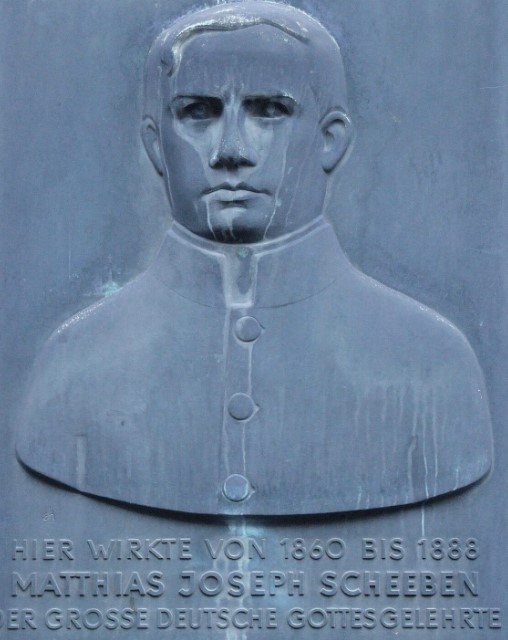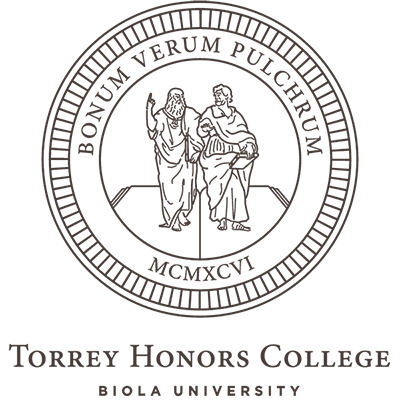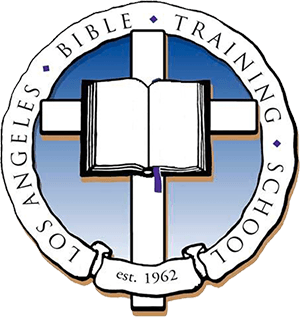A scene from The Canterbury Psalter (12th century)
Blog
Scheeben: Keeping the ‘Christ’ in Christology

Matthias Joseph Scheeben (1835-1888)’s treatment of Christology fills hundreds of pages in the soteriological fifth volume of his Handbook of Catholic Dogmatics (originally published 1880s; ET 2020). It’s got all the comprehensiveness, detail, and synthetic force that are hallmarks of his work.
It’s hard to characterize what’s unique or distinctive about a work so deeply traditional and fundamentally conservative. But here’s an angle on Scheeben’s Christology: it’s organized around the name Christ. In a few places, Scheeben emphasizes the fact that the discipline of Christology is rightly so called: it is the study of Christ, and the name ‘Christ’ contains the entire scope of the doctrine.
Scheeben surveys “the personal names of the Redeemer,” distinguishing them into “two categories, depending on whether they have directly in view the man or the God.” (56) The leading names that pick out the humanity of the redeemer are his proper name Jesus, and his self-chosen title Son of man. The leading names that focus on his divinity include Emmanuel, God incarnate, and Word incarnate.
But the name Christ is, for Scheeben, a unique name that synthesizes all of them. It picks out the one person of the redeemer and relates his two natures. “The Anointed One” covers all this ground, “insofar as the name is taken in all the fullness and force of its meaning.” When that “fullness and force” is recognized,
this name designates (as will be shown later) a human person who is constituted with divinity by an anointing and endowed by virtue of His constitution with divine attributes and thus is capable of performing all the functions of the Redeemer by Himself and infinitely exalted over all mere children of men. Hence this name contains in a nutshell –under a metaphorical cover, granted, but in an extremely significant way– the entire content of the doctrine about the Person of the Redeemer, which is why this doctrine can be regarded as only a development of its content and thus very significantly can be called Christology. (56)
It’s not until a couple hundred pages later that Scheeben has the opportunity to elaborate on these hints. He does so under the heading (section 222, beginning on p. 241) “The name Christ, or the Sanctified, or the Holy One of God, as essential name of the Person designated thereby.” He admits that the incarnate reality is composite, and thus that “there can be no simple nature-name for it, but rather every expression that is supposed to designate its peculiar being must refer to its twofold nature.” (242) He has already discussed the composite term “God-man,” and weighed how it functions in multiple languages (58). But he is delighted that alongside such venerable theologoumena we also are given
a simple name which, by referring precisely to the two natures, and indeed these two particular natures, expresses the peculiar constitution of the Incarnate Word figuratively, granted, but in an extremely poignant way and consequently is not merely a personal name, like Jesus, for example, but also so to speak a species name and an essential name of the Person designated thereby. It is precisely the name Christ…(242)
To get the name Christ to do so much conceptual work, Scheeben’s key move is to explain it from its metaphorical depth and its highest significance:
In order to understand this, we must start from the premise that the name Christ = the Anointed One designates its subject as the Anointed One absolutely and par excellence. Above all this premise includes the idea that by ointment we understand directly and in the first place not a material ointment, nor even a merely moral consecration or a spiritual quality, but rather a substantial spiritual ointment or the supreme spiritual, divine substance, which alone as opposed to other spiritual substances can ahve teh character of ointment. (242)
And here, dear reader of this personal blog, I break off my exposition for now. I reserve the right to come back and take some more detailed public notes. In the pages following 242, Scheeben develops the biblical image of anointing in fascinating ways (he includes the golden sheathing of the wooden Ark of the Covenant to be a more significant image than the application of oil (“here no real union takes place”); a kind of super-anointing at the heart of the holiest). He explores patristic recognitions of “the constitutive significance of the name Christ.” He explains how a proper understanding of the name systematically excludes Apollinarianism, Eutychianism, Nestorianism, and anything else that ever ran afoul of conciliar Christology. He spends some time on “a non-metaphorical expression in Sacred Scripture corresponding to the name Christ,” which is simply the name “the Holy One,” or “the Sanctified of God,” or “the One who is absolutely holy through absolute sanctification.” (251) And finally, he concludes that
The name Christ proves to be a proper essential name of the Person of the Redeemer especially also in the fact that in it the other names with which the Person in question is designated in the Creed are contained or find in it their full explanation. (252)
There is a lot more going on in Scheeben’s Christology, and what I’ve highlighted here is not, by volume, the main thing. But in a Christology largely developed by analysis of the biblically given names of Christ, quite a bit does depend on Scheeben’s elevation of this one name to the status of a comprehensive word. It’s an impressive consolidation of material, and an attractive concentration of meanings into an image both biblical and traditional. Scheeben’s elevation of the name Christ may risk displacing the name Son from its proper place at the foundation and center of the doctrine. There are numerous apparent digressions that have to deal with questions that the impressive Christ-title-focus has pushed to the side. Scheeben does not suppress the fact that “God anoints man” is more central to his treatment than “Father anoints Son,” and he lays out some careful reasoning for how these two schemas are related. Later he takes up a vexed question for his local sub-tradition of Roman Catholic theology, about whether there is or is not a “second sonship” relation established by the assumption of human nature: he says there cannot be (on pain of Nestorianism), but the many pages and the fancy footwork involved show Scheeben’s awareness of the considerable cost of being accountable to Scripture and tradition while maintaining the unique emphasis on the title Christ as the orienting center of this doctrine, which “very significantly can be called Christology.”
___________
p.s. By one account, the term Christology was coined around 1620 by Lutheran theologian Friedrich Balduin, commenting on Romans 8:3-4. This passage, he said, contains the true Christology, deploying a Greek word in his Latin text. Balduin’s main point was that “God sending his own Son in the likeness of sinful flesh” is a comprehensive statement, including the Son as both divine and human, the eternal Son as incarnate redeemer. Scheeben inherited the term from Roman Catholic dogmatics, but I’m not able to trace how the term migrated from Balduin’s commentary to a broader ecumenical usage (nor can I independently confirm the claim that Balduin’s coinage was absolutely the first).
About This Blog

Fred Sanders is a theologian who tried to specialize in the doctrine of the Trinity, but found that everything in Christian life and thought is connected to the triune God.


